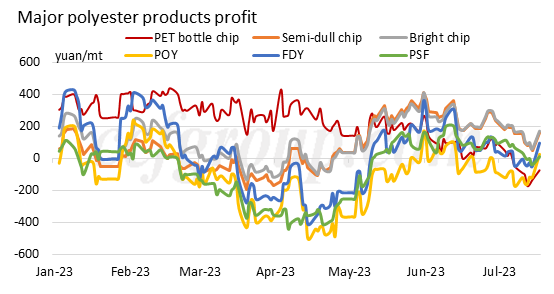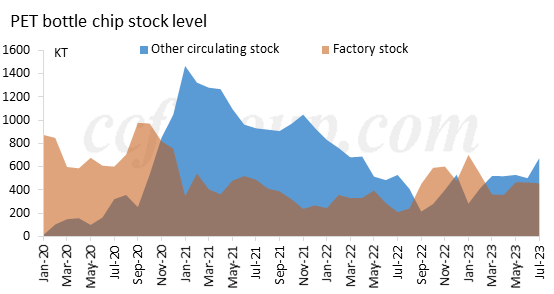Will PET bottle chip producers consider shutting down or cut output under losses ?
Recently, many people have been asking why PET bottle chip factories are running at a deficit but not stopping production.

First of all, when a polyester factory chooses to reduce production, except for annual maintenance, it is generally a reluctant decision made after considering factors such as efficiency, inventory, and demand trends. It is a buffering measure. Short-term compression of processing spread does not mean the factory will completely stop production or reduce output, especially considering that a decrease in operating rate will correspondingly increase unit costs.
Secondly, currently, the average physical inventory of PET bottle chip factories is not high, and if contract sales volume is taken into account, major factories have received a reasonable number of orders. Supply of near-term goods is not much. However, why is there a discrepancy between market perception and actual data? It is understood that most of the inventory currently exists in the trading sector, and with end-user customers not actively buying, there is a temporary surplus in supply. Of course, some manufacturers that have newly added capacity this year will continue to take in orders for the current month while meeting monthly targets. One key reason for this is to moderate overselling in order to stabilize market prices and alleviate future sales pressure.

Furthermore, during the summer months, PET bottle chip delivery volume both in and abroad is expected to be high, therefore, reducing production in July and August is not a cost-effective solution. Generally, PET bottle chip factories tend to increase sales volume when raw material cost is high, so they can lock in costs and make profits when raw material prices decline later. This approach can be relatively aggressive, and if there is a sudden surge in PTA prices like what happened in the third quarter of 2018, PET bottle chip factories may find it difficult to make a profit and are at a higher risk of incurring losses.
In addition, the industry is closely watching signs of export market recovery. The focus is primarily on the United States, the European Union, and the South American markets. It is reported that local inventory digestion in the United States is basically complete, and the South American market is gradually entering a destocking phase in the second half of the year. However, there is no significant improvement reported in the European Union. With the arrival of summer, downstream demand for PET bottle chip is gradually increasing. Due to anti-dumping measures, China is currently unable to directly export to the US market. However, in recent years, South Korea and Vietnam have been US main sources of PET bottle chip imports from Asia. Therefore, if PET downstream factories in US and South American choose to resume purchasing raw materials from Asia, Chinese PET bottle chip factories may indirectly receive more orders in the future.
Overall, although the Chinese PET bottle chip industry is currently facing pressure from new capacity release and reduced new orders, the probability of concentrated maintenance shutdowns is low in the short term. Based on the current delivery speed of existing orders and progress in new capacity launch, we expect that the probability of arranging output reduction by late August or early September is relatively high.
- Top keywords
- Cotton Price
- Cotton Futures Price
- Cotton Futures
- CZCE
- PTA Futures Price
- Chemical Fiber
- Polyester Prices
- Wool price
- PTA Futures
- Shengze Silk
- China
- Yarn Price
- price
- China Textile City
- Fibre Price
- Benzene Price
- Cotton
- Index
- Cotton Index
- PTA
- fabric price
- NYMEX
- Top 10
- textile industry
- Spot Cotton
- Cotton Yarn
- Polyester Price
- Futures
- PTA Price
- cotton yarn price

